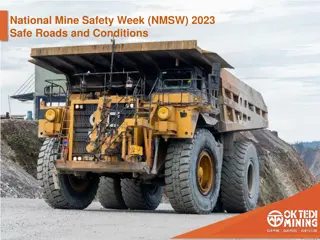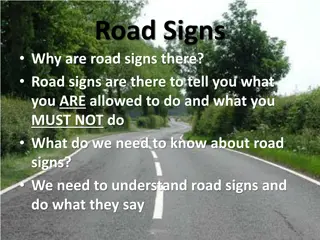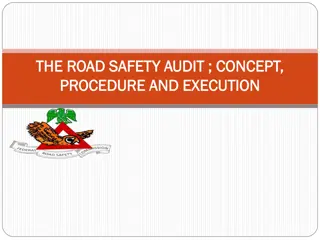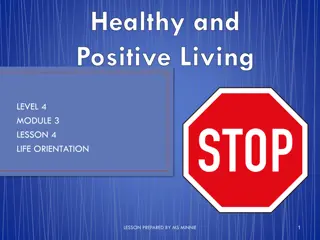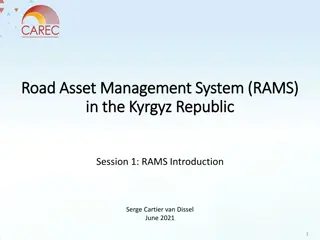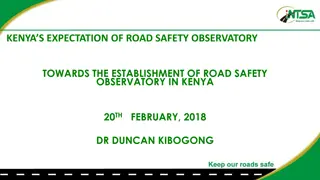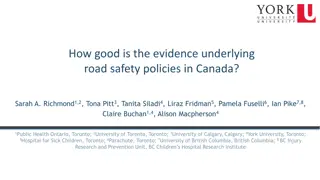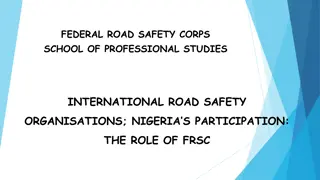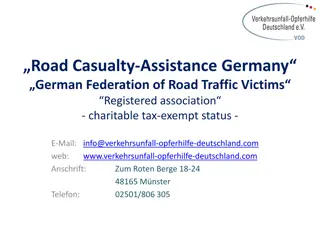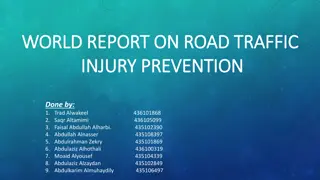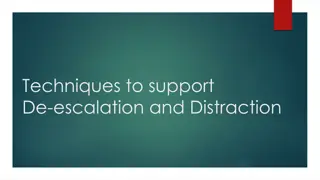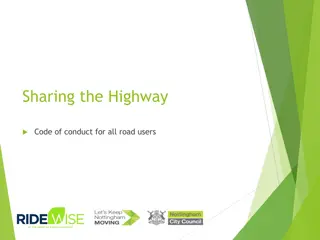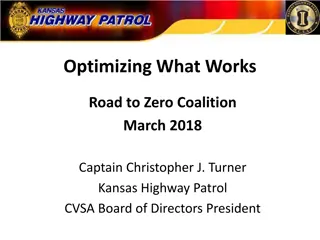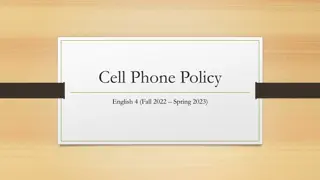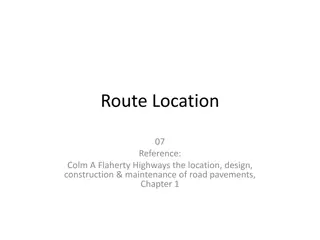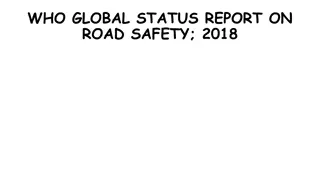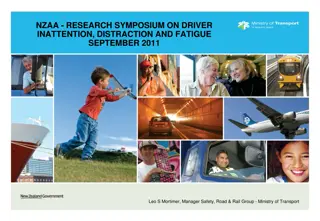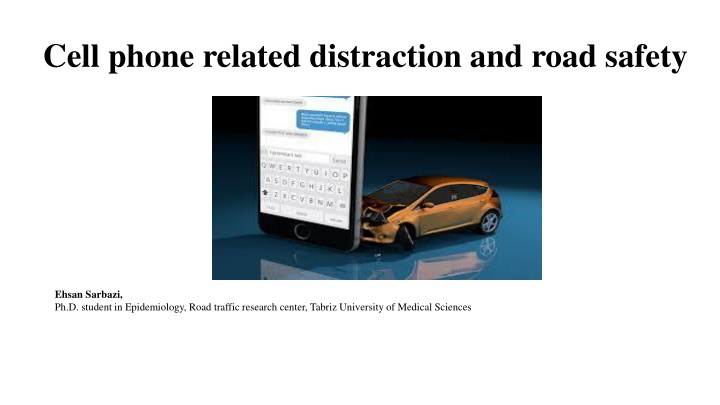
Road Safety Concerns: Cell Phone Distraction and Driving
Explore the impact of cell phone use on road safety, including statistics on distracted driving accidents and the prevalence of smartphones. Learn about the risks associated with driver distraction and the importance of promoting safe driving practices to reduce road traffic injuries and fatalities.
Download Presentation

Please find below an Image/Link to download the presentation.
The content on the website is provided AS IS for your information and personal use only. It may not be sold, licensed, or shared on other websites without obtaining consent from the author. If you encounter any issues during the download, it is possible that the publisher has removed the file from their server.
You are allowed to download the files provided on this website for personal or commercial use, subject to the condition that they are used lawfully. All files are the property of their respective owners.
The content on the website is provided AS IS for your information and personal use only. It may not be sold, licensed, or shared on other websites without obtaining consent from the author.
E N D
Presentation Transcript
Cell phone related distraction and road safety Ehsan Sarbazi, Ph.D. student in Epidemiology, Road traffic research center, Tabriz University of Medical Sciences
Cell phone Amobile, cellular, cell , hand phone make and receive calls over a radio frequency .
Smartphone Multimedia :music, video, cameras, and gaming Wireless: Bluetooth, Wi-Fi Sensor: barometer, gyroscope, or accelerometer Internet services : web browsing, mail and Social networking(Facebook and Twitter,Instagram,whats App) video calls, streaming movies Voice calls Text messaging
Smartphone ownership in the U.S. 2015-2018, by age group Mobile phone use is greatest among the young In the United States (US), 68% of children ages 12 13 83% of children ages 14 17 owned a cell phone in 2013
list of countries by smartphone penetration in 2019(Newzoo's Global Mobile Market Report 2019) Iran: 2017, 37% in 34th rank. 2019 , 54.8% in 11th rank
ROAD TRAFFIC ACCIDENTS Death Rate Per 100,000 Age Standardized Road traffic injuries are the leading cause of death worldwide among those aged 15 29 years Iran:29.37 Female:15.07 Male:43.22 Rank country Rate 1 ZIMBAB WE 61.90 42 IRAN 29.37 183 SWEDEN 2.31
Driver distraction from cell phone use In 2009, NHTSA 5474 killed in crash 18% (995) cell phone distraction. cell phones 3% of all crash fatalities. GHSA reports (2011) 22-25% of crashes and as many as 16,000 fatalities are caused by cell phones
Facts About Distracted Driving Annualy1.3 million people die and 50 million are injured as a result of road traffic accident In 2030, road traffic injuries (9th) leading cause of death globally to become the 5th. 3,331 people died due to a distracted driver(2011) 10% of all crashes, distracted driver.
Cell phone as a risk factor of road safety Advantages: convenience, entertainment, and education But Cell phone distraction is an important contributor to road traffic crashes.
Distraction definition Distraction:diversionofattentionawayfromactivitiescriticalforsafe driving towards a competing activity. attention divided : primary task (driving) secondary tasks not related to driving ( cell phone conversation) source of distraction: internal :tuning a radio, mobile phone, external : static /video advertising billboard or watching people on the side of the road
Types of distractions: Visual distractions Manual(physical, motor) distractions Cognitive distractions Auditory(noise,aural)distractions
Visual Distraction: Anything that shifts a driver s eyes away from the road to something unrelated to the primary task of driving EXAMPLES: billboard, accident scene, looking at street signs
Manual Distraction: Anything that causes a driver to remove one or both hands from the wheel or other driving controls EXAMPLES: eating, programming a GPS, adjusting the radio, texting or dialing a cell phone
Cognitive Distraction: Anything that takes a driver s mind(thinking), thoughts or mental attention away from the task of driving EXAMPLES: anger, anxiety, fatigue, pain or worry
Auditory distractions Responding to a ringing mobile phone, or if a device is turned up so loud that it masks other sounds, such as ambulance sirens) Nearly all distraction-related crashes involve a combination of two or all . Calling (manual), looking (visual), and thinking about what to say (cognitive).
Internal sources of driver distraction Loud and unruly passengers Activity from pets or children Grooming oneself(comb or brush hair20% , put on make up14%) Adjusting radio, CD Reaching for fallen objects Moving an object in the vehicle Reading/ using a navigation system like a GPS 41% read maps, books, newspaper 36% surf the internet 13% Eating or drinking 86% Adjusting temperature controls Smoking Medical condition, alcohol or drug use, fatigue Using a device integral to the vehicle (e.g. speed adaptation system) Portable electronic devices : laptops, iPods, Blackberry's, CELL PHONES
Distraction-safety behavior Walking, bicycling and driving require visual/perceptual skills to evaluate dynamic (constantly changing) environments As the environment is perceived, information is cognitively processed and efficient decision-making about environment engagement is required for safety. Anticipatory behavior and executive function skills are essential. Dual-task (similar tasks) like mobile technology use and negotiating traffic are largely visual and cognitive activities.
Reporting of cell phone distraction In most countries data on distraction are not routinely collected also Police report not include distraction factor. Text messaging are underreported also. There is very little data available on the prevalence of hands-free phones. Distraction coding often lacking compared to other crash predictors, e.g., bad weather.
Prevalence A recent electronic survey found distracted drivers to make up 72% of the population and distractions were causative in 9% of crashes. In London, car drivers use (4.8%) for hands-free phones. The proportion among taxi drivers and van drivers using hands-free phones was considerably higher, at 14.3% and 9.9% respectively.link About31.37% of road crossings were made by adolescents with a phone or other device Insurance Institute of Highway Safety (IIHS) manipulating a cellphone in 2018 than in 2014(57%)
Percenage of distraction-related crashes Country percent* Australia 14 New Zealand 9 Colombia 9 Spain 37 Netherlands 8.3 Canada 10.7 United States 11 Great Britain 2 *% of crashes related to distraction
Text messaging while driving United Kingdom: 45% of drivers have text messaging United States :27% sent or read text messages while driving Australia: 58% of drivers aged 17 29 read text messages while driving, and 37% sent text messages In Iran where prevalence of driver texting was 4% in 2014 .
How ? longer reaction times (braking, signs..) lane change frequency, slower vehicle, checking mirrors The driver s situational awareness, decision-making Reaction times (phone slower than talking to a passenger ) Young drivers crash risk is significantly increased by the presence of similarly aged passengers in the vehicle video adverts: more risk of this form of external distraction statics pedestrian : cognitive distraction reduce situation awareness Hands-free phone: cognitive distraction When distracted by visually demanding tasks (e.g., texting), pedestrians waited longer, missed more opportunities to cross safely
Relative Risk In a study 26,798 cellular-telephone calls 14-month adjusting age and driving experience The risk of a collision when using/not being used (RR=4.3(95 CI, 3.0 to 6.5). hands to be free :RR= 5.9
Odds Ratio Cell phone conversation while driving increases collision risk by 4 to 6 times Conversation less risky than text messaging truck drivers , who texted , 23 times have more crash or near-crash incident Study using General Estimation System database showed that cellphone distraction resulted in significant higher risk (OR= 11.56) of rear-end collision for teenage drivers. In a crash culpability analysis comparing crashes with and without cell phones, it was found that the risk of a culpable crash was increased by 70% when a cell phone was present A number of naturalistic studies :cell phone conversation ,in some circumstances, provide a protective
Cohens d effect size Variable K N r* d* Lower 95% CI Upper 95% CI Lower 95% Crdl Upper 95% Crdl HF vs. baseline 8 478 0.31 0.66 .16 .47 -.05 .68 HH vs. baseline 3 164 0.20 0.41 .04 .36 .09 .31 Type/Read vs. baseline 5 286 0.32 0.68 0.03 0.62 -0.20 0.84 Interpreting criteria: Small effect (0.20 0.49) Medium effect (0.50 0.79), Large effect (> 0.80). *There are generally two categories of effect size: d for two-sided data and r for continuous.
High risk group Cell phone distracted driving Young drivers (16 to 20 are at highest risk) olderthan 65 were at higher risk when using cellphone Young drivers 80% admit to texting while driving High school drivers :79% had ever used a cell phone 71% had ever texted while driving
Masking effect and Self-Regulation Masking effect : Given that the evidence points to a risk ratio for cell phone use that is greater than one, the fact that crash rates have dropped at the same time that cell phone subscriptions have increased dramatically begs explanation. Self-Regulation Drivers may choose when and where to use the phone in such a way that they do so under more benign driving conditions.
PopularStudies designs in cell phone distracted driving Case-crossover Advantage: Own control, exposure to a transient risk factor (e.g. cell phone use) at the time the outcome of interest (e.g. a crash) occurred, with exposure during a control time period Disadvantage :Not adjusting driving environment, road type, time of day and weather, lack a crash-free control group, limiting generalizability Crash culpability analysis Driver actions, the driving environment, traffic flow, road surface, weather conditions and other indicators.
Reducing Distractions NEVER text or email, calls Never use Hands-free Make use GPS and all paperwork before starting a trip limit using Voice-activated systems (cognitive distraction) while driving Legislation on mobile phone use in vehicles public awareness of the risk of distracted driving. Evidence-based research and interventions
Reference World Health Organization. Mobile phone use: a growing problem of driver distraction. A meta-analysis effects of texting on driving Vegega M, Jones B, Monk C. Understanding the Effects of Distracted Driving and Developing Strategies to Reduce Resulting Deaths and Injuries: A Report to Congress. Washington, DC: National Highway Traffic Safety Administration; (2013). Association between cellular-telephone calls and motor vehicle collisions Conversation with passengers is the most frequent secondary task followed by eating, smoking, manipulating controls, reaching inside the vehicle, and cell phone use Driver Distraction: A Review of the Current State-of-Knowledge DRIVER DISTRACTION FROM CELL PHONE USE AND POTENTIAL FOR SELF-LIMITING BEHAVIOR Adolescents Mobile Phone Use While Crossing the Road www.operationsafedriver.org Use of social media while driving from an orthopedic resident's perspective An evidence-based review: Distracted driver


